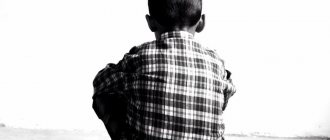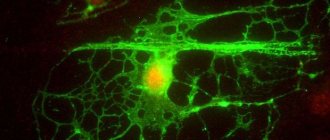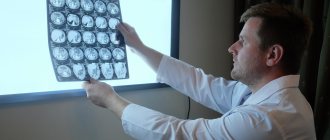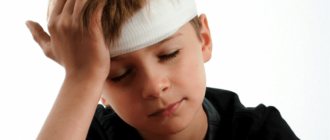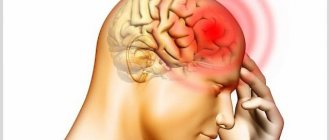The human brain undergoes the greatest transformations in the first years of life. It is in infancy that intelligence and abilities, “mind and feelings” are formed. Parents need to try to ensure that the baby’s brain develops intensively and harmoniously. What needs to be done, what methods are there? Did you know that the development of a child’s brain begins in the womb and in the first year of life takes on an avalanche-like character? Let's try to trace the entire process from birth and find out what adjustments parents can make to it using the latest techniques.
Mind and body must develop in harmony
It often happens that mothers of babies aged more than a year or two notice obvious deviations in behavior and rush to a neurologist for help. Obvious signs of dysfunction of the central nervous system can be corrected in most cases, but it would be worth paying attention to the problems much earlier. Many mothers remain captive to stereotypes: it is believed that a baby under one year old is simply stupid; parents pay much more attention to the fight against digestive problems, allergies, colds and other physical health problems, leaving deviations in psycho-emotional development out of the scope. Without denying the importance of physical development, one must not miss the precious days of intensive formation of the intellect!
Processes of brain development that can only be judged by the result
Here are some very compelling facts about brain development in the first days and months of human life:
- By the end of the first year, a baby's brain doubles in size and weighs 1 kg - almost half the weight of an adult brain.
- In one second, about 700 synapses are formed in the baby's brain. This is a neural connection that is formed in the process of a little person getting to know the world around him and gaining any experience. Billions of neurons in the baby's brain are exceptionally active in the first year of life, especially in the sectors of the brain responsible for physical development, color perception, emotions, speech functions, and smell.
- Infants are very emotional; with the help of emotions they express their attitude to surrounding events. The amygdala is responsible for the manifestation of emotions, but the frontal lobes, responsible for intelligence, develop slowly as the child “gets smarter.”
How to learn to control brain development in children, ensure the development of abilities with age, and increase IQ to record levels?
Child brain growth and development
If we take the entire period of formation of a child’s brain, then its main part (up to 70%) occurs during the period of intrauterine development. For the first year - 15%, another 15% - for the period from one year to 6-7 years. By the age of 6-7 years, the structure of the brain is almost completely formed and differs little from that of an adult. This is precisely the reason for establishing the optimal age threshold for starting school: the brain is already ready to assimilate information that becomes more complex every year and form logical connections.
From conception to birth
From the point of view of anatomy and morphology, the child’s brain is formed literally in the first weeks of fetal development, and by the third week of pregnancy it is already possible to consider the division of the brain into three parts.
Sonya is visiting her grandmothers. Talking to mom on the phone: “Mom, when will you pick me up?” - Do you know how many fingers there are on a hand? I'll be back in so many days. - Mom, it’s a pity you don’t have three fingers.
From birth to one year
With the advent of tomography, scientists have discovered that the microstructure of a child’s brain begins to form immediately after birth. After birth, a baby already has hundreds of billions of neurons - nerve cells, but the connections between them are primary and not structured. It is in the process of interaction with the external environment that stable connections are created between neurons, a kind of “network” or “web” is formed, a tree-like structure of neurons is created, and the development of the brain hemispheres in children occurs.
As soon as you rattle the baby with a rattle, he immediately forms stable connections that characterize the image, shape, color and sounds emitted by this object, characterizing its movement and relationship with the mother’s hand and with the mother herself. The example is simple, but that's how it works, from simple to complex. It’s not for nothing that a very specific baby can learn any language on the planet!
The structure of the network of neurons becomes more complex every minute and every day, and the infant’s cerebral cortex thickens (its thickness is a criterion of human intelligence). Motor activity and the development of child brain functions are closely interconnected: the structure of the cerebellum and vestibular apparatus is being formed, connections are being established between the cerebellum and the frontal area of the cerebral cortex, which is responsible for thinking.
Development of both hemispheres of the brain occurs, but not always evenly. Scientists believe that a certain asymmetry is the norm rather than the exception. In girls, the left hemisphere develops more intensively, in boys - on the contrary, and brilliant people in most cases have a more developed right hemisphere.
From one to three years and beyond
By the age of three, the brain volume reaches 80% of the adult brain. Intelligence grows, the ability to think and speech functions develop, and stable social connections are formed. After three years, the rate of brain development begins to gradually decline; by the age of 10, it is too late to correct anything.
What is your baby learning?
In the sixth and seventh weeks of pregnancy, in parallel with the brain and spinal cord, the child’s peripheral nervous system is formed: in it the largest cranial nerves can already be distinguished5. They are needed so that the baby’s brain quickly collects and processes information received from all parts of his body. By this time, other large organ systems begin to develop: the heart beats, the liver creates the first blood cells, and the kidneys grow. Also, the child’s arms and legs grow, eyes and ears form, the baby is already becoming like you. Every day he improves more and more, constantly learning new things.
In the second trimester of pregnancy, development continues: the baby already hears your voice and all external noises, and actively explores his body and the environment with his hands. He touches the umbilical cord, sucks his thumb, and develops the reflexes necessary for the future. He coordinates the movements of his limbs and trains daily. You can already feel his rhythmic kicks and thrusts from within. Also in the second trimester, the baby begins to open his eyes, now he may be frightened by bright light and shudder.
The second trimester also begins the process of myelination. This is “protective isolation” for each nerve, it improves its functioning so that your baby quickly learns new things. By the time of birth, the process of myelination is not completely completed; it continues during the first years of the child’s life. In the fifth month of pregnancy, the cerebral hemispheres are still smooth, but when your baby is born, they will already have convolutions and grooves.
John Medina on how to develop your baby's brain
The popular book by the American author can be purchased or downloaded on the Internet. In his work, the researcher states that “all children are different and all parents are different, so there is no advice for all occasions.” Taking as a basis the individuality of both babies and their parents, Medina encourages spending as much time together as possible and turning this time into a fascinating process of learning about the baby, his needs, his already developing character.
In his book, the scientist pays great attention to the methods and techniques of developing the brain and thinking in young children, and warns against typical mistakes of inexperienced parents.
ESSENTIAL BOOKS FOR PARENTS
An independent child, or How to become a “lazy mother”
The single and most important mission of parents is to teach their child to be independent. Educator and psychologist Anna Bykova offers the “lazy mother” method. You will allow yourself to be more than just a parent, you will get rid of feelings of anxiety and the desire to control everything, and you will be ready to let your child go into independent life.
Developmental activities for the “lazy mother”
A new look at the problem of child development - teacher and psychologist Anna Bykova invites parents to rely not on fashionable pedagogical systems and advanced toys, but to connect their personal experience and creative energy. In this book, you'll find concrete examples of fun activities and learn how to have fun with your kids, no matter your schedule or budget.
Montessori. 150 activities with your baby at home
It is known that it is at an early age that children are most receptive to learning. Maria Montessori's book will teach you a unique method that is aimed at comprehensive development from the very first months of life. 150 exercises and useful tips will become an indispensable assistant in raising a child.
Montessori. Developing confidence in a child
In this book you will learn how to help your child develop the most important character quality - self-confidence. By following the recommendations and principles of the Montessori method, you can create the right developmental environment for your child, help him become independent and instill a love of learning. And thanks to your sensitive support and attention, he will gain faith in himself and his strength.
Early development: how good is it and what needs to be done?
The ideas of early development are by no means new; they are already hundreds of years old. It is believed that even during pregnancy, not only the expectant mother, but also the child in the womb receives undoubted benefits from going to concerts of classical or simply pleasant, positive music; the mother should receive as many positive emotions as possible. After birth, adherents of the ideas of early development try to talk with the baby as much and on serious topics as with adults, sometimes in several languages, play Mozart and everything that they themselves like to listen to. It is believed that this stimulates the development of the child’s brain “from the cradle”.
By the way, John Medina is very skeptical about “music for the belly,” lectures on quantum physics and showing advanced educational videos to a baby on a screen the size of half a wall. He insists on the thesis “for everything there is a time” and appeals to common sense and a sense of proportion. Medina says a box of crayons, an engaged, cheerful parent and a couple of hours will do much more for a baby's brain development, and the effects will be much more permanent. Like in this video:
Today, advanced marketers have created and successfully cultivated a real fashion for early development: any store offers children ingenious toys and devices, rugs, even gadgets. All kinds of developmental courses and trainings for mothers with babies are very popular. The baby is literally overloaded with information that he doesn’t really need at this age. Experts say that long-tested cards, simple balls and cubes, and dynamic gymnastics are quite sufficient. Try to communicate a lot and often to stimulate the development of speech functions.
The best advice for moms and dads : read fairy tales to your baby: dozens of generations of our ancestors could not have been wrong!
More tips to avoid getting bored with exercises
I know that most of you, dear friends, find it difficult not only to get your kids to do exercises, but also to get them up early in the morning. But disciplined parents have the same children. If you have not learned to go to bed on time in the evening, then it is logical that in the morning you will face daily turmoil. Try to change the situation while the child is in kindergarten. For school, it is extremely important to develop a proper daily routine with mandatory morning exercises.
In order not to quickly get bored with the first complex, I also provide a list of exercises for alternation. As you'll notice, they won't always require both hands, but that doesn't matter. Be that as it may, regular exercise will ensure excellent development of the right and left hemispheres of the brain. I advise you to take them seriously too. They say that in this way you can save yourself from all-consuming sclerosis (have you noticed this yet?):
- Massage: using the edge of either the right or left palm, we rub the forehead from the roots of the hair to the bridge of the nose and back.
- Kinesiology: hands clasped, fingers intertwined. Now we make circular movements with each finger in turn, without unclenching the lock.
- Physical education: arms to the sides, eyes closed and walking along an imaginary log.
- Ball: we connect the fingers of both hands in a ball shape. We press our fingers on the fingers while opening our mouth wide.
- To develop creative abilities: place the left hand on the tummy, the right hand on the forehead in the center. The eyes are closed. We massage our forehead in a circular motion, imagining a blue ball.
- With both pens we simultaneously draw circles, loops, and letters in the air.
- Sitting on the floor, grouped, we roll back and forth like a ball.
- A complex but effective kinesiology exercise: the fingers of one hand show the “okay” sign, and the other hand shows the “peace” sign. Now do the opposite and alternate, picking up speed.
- Head turns: turn your head to the right, then slowly move your chin down through your sternum and to the left. Then back.
- We stroke ourselves: with our palm we gently move from the top of the head along the face, along the neck to the chest, with the other hand - from the top of the head to the base of the neck.
An interesting technique by Makoto Shichida
A professor from Japan is convinced that efforts should be directed to the development of right hemisphere , because it is known that the right hemisphere is responsible for creativity, creativity, and imaginative thinking. A child with a well-developed right hemisphere learns to remember a large amount of information, and his ability to learn foreign languages increases.
The Japanese scientist’s method is based on the following statements (sometimes controversial):
- All children are initially geniuses, that is, endowed with unlimited potential for mental development.
- Only constant and systematic training with the baby will bring the desired result.
- Repeated repetition for the purpose of memorization is not a very good method, as it promotes the development of the left hemisphere rather than the right.
- Proper brain development requires simultaneous stimulation of all five senses.
Children say! -Daughter, why are you so vindictive? “I don’t know, mom, but our dad is kind!”
For classes, special cards are used, they encourage the child to imagine and fantasize, and there are special games. Finding a technique is easy: there is quite a lot of information on the Internet. Perhaps the formation of visual memory is of paramount importance for children in Japan or China: after all, this ability is critical for mastering hieroglyphic writing. In other languages, like Russian, there is more internal logic and grammar than visual images. Nevertheless, the technique is interesting!
What are some ways to activate your brain?
I want to repeat for the hundredth time that there is a close connection between brain activity and finger dexterity.
Based on this, in childhood, especially early childhood, you need to start stimulating processes in the hemispheres by training your fingers. A lot has been written about this, but almost all of my materials are, to one degree or another, devoted to issues of motor skills, sensory skills, etc. But hand exercises are only one component of a set of activities for children. The main, in my opinion, areas of work related to enhancing intelligence:
- Finger gymnastics;
- Logorhythmics;
- Kinesiological training;
- Self-massage;
- Neuroscience;
- Articulation and breathing exercises;
- Creative activities;
- Didactic games and tasks;
- Mnemonics;
- TRIZ;
- Educational activities in mathematics, speech development, etc.
As for finger gymnastics, creative activities, didactic games, mnemonics, logorhythmics (gymnastics with recitation), TRIZ and educational activities, I write about this all the time.



